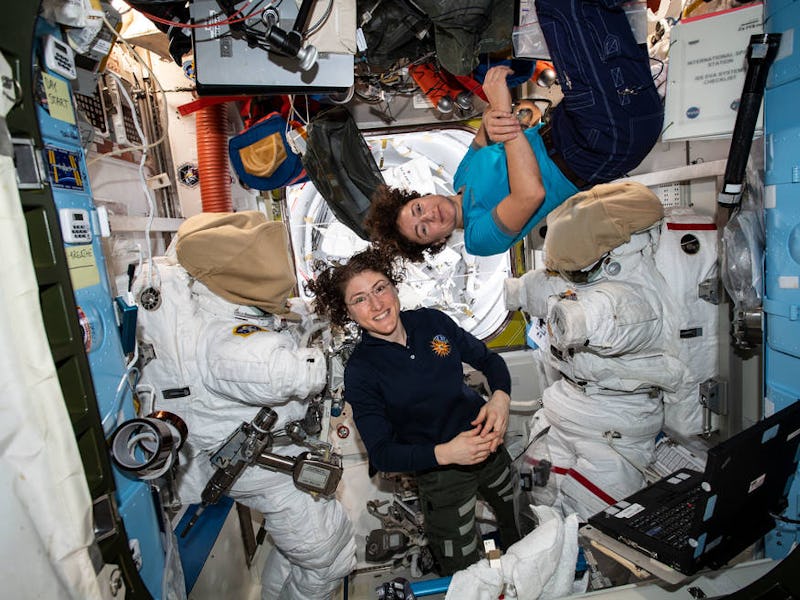How 20 years of the ISS affects humanity's odds of living in space
Before Elon Musk can establish his Mars city or NASA build a lunar base, scientists need to keep humans safe in space.

Twenty years ago, humans made a home in low-Earth orbit.
On November 1, 2000, the International Space Station, an orbiting complex flying 254 miles above Earth's surface, began hosting astronauts. The ISS is essentially a five-bedroom home, replete with a gym, two bathrooms, and a 360-degree window with a view that can't be beat — looking down on our planet from above.
Since then, 240 people have been on the ISS, living in space for sometimes more than a year. Their presence has left a lasting impact on how scientists understand the effects of spaceflight on the human body.
NASA's Human Research Program relies on the astronauts onboard the ISS for studies on how the human body adapts to time spent in a microgravity environment and whether the effects of being in space can cause permanent damage to human beings.
This research is crucial to humanity's future, as space agencies set their sights on missions to far out destinations like Mars.
Here are five key things scientists have learned so far from the astronauts living on the ISS:
Double trouble
In 2019, NASA published the results of their famous Twin Study, in which NASA astronaut Scott Kelly spent nearly a year on the International Space Station, in a mission launching in 2015, while his identical twin Mark Kelly remained on the ground for the duration of that mission.
Scott spent a year in space, while his twin stayed on the ground to compare how the microgravity environment would affect the astronaut's body.
Scientists monitored the twins before, during, and after the mission, taking note of how their bodies changed during that time. Following his time in space, Scott Kelly experienced decreased body mass, instability in his genome, swelling in major blood vessels, changes in eye shape, metabolism shifts, inflammation, and alterations in his microbiome that his Earth-bound brother did not.
Fighting bone and muscle loss
While floating in microgravity, humans onboard the ISS don't use their bones and muscles to support the full mass of their bodies in the same way they do on Earth. Despite enforcing a routine of regular exercise and proper nutrition in space, being in a microgravity environment seems to cause astronauts to lose some of their bone and muscle mass.
This has been a major area of study for human spaceflight, particularly on the ISS. Several studies have been conducted so far, and scientists are in the process of developing drugs that may help combat the breakdown of bones and muscle in the human body.
These drugs are not only useful for astronauts, but could be used in people here on Earth who experience bone and muscle atrophy due to aging, sedentary lifestyles, and illnesses.
Heartbreak
Bones and muscles are not the only things that lose mass while in space — the heart does, too. Being in a microgravity environment appears to decrease the amount of blood in the human body. In turn, the loss of blood causes the heart to change shape and become more round.
The change in shape not only makes astronauts' hearts look odd, but it also causes them to pump blood at a decreased pressure. As a result, they can feel dizzy and lethargic while in space.
Blurry vision
Several astronauts returning to Earth reported a change in their vision. Some experienced blurry vision that went away, while others say they now need reading glasses to be able to see up close.
Scientists hypothesize that increased pressure caused by fluid going into astronauts’ heads as a result of being suspended in a microgravity environment could be reshaping their optic nerve — changing the structure of their eyes.
They are still working to figure out whether these effects are permanent, and find ways to protect astronauts' vision in space.
Puffy face
Previous research suggests long missions in space started to change the volume of tissue at the top of astronauts’ brains, and decrease the amount of protective fluid surrounding their brain.
Scientists are yet to narrow down the exact cause behind these structural changes in astronauts’ brains. One reason could be what’s referred to as “puffy face syndrome,” which can be seen clearly in pictures of astronauts in space. Fluids travel towards the head of people living in space without gravity pulling the fluids down, resulting in a puffy face.
Researchers are working on ways to help force fluids down, instead of them climbing up towards the brains of astronauts in space.
The future of humans in space — The fact that the ISS has functioned as a floating lab for studying human life in space for two decades is no mean achievement. Together, the science so far has painted a worrying picture of how space environments affect human health and longevity — but armed with this information, scientists can work to make space flight safer for humans before we venture further into the cosmos.
As we get closer to traveling into the great unknown over the next two decades with the Artemis mission to the Moon and Elon Musk's venture to send humans to Mars, knowing our own bodies' limits will enable us to go further into space and for longer than ever before.